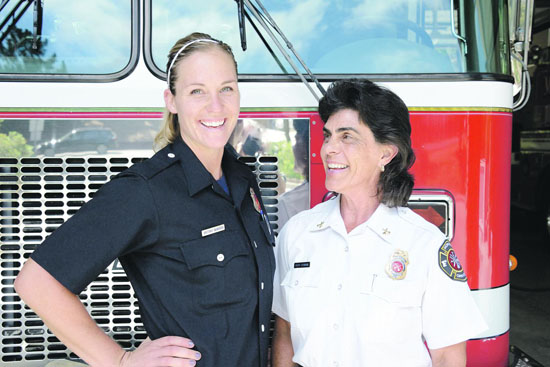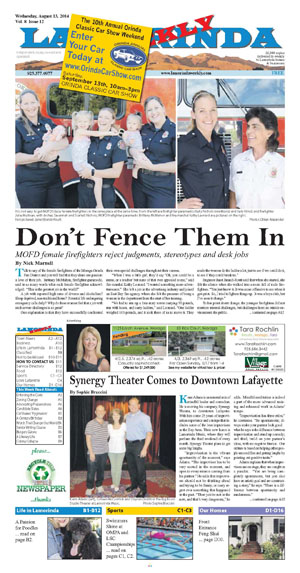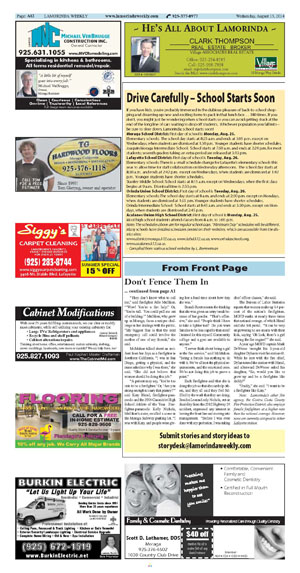|
|
Published August 13th, 2014
|
Don't Fence Them In
|
| MOFD female firefighters reject judgments, stereotypes and desk jobs |
| By Nick Marnell |
 |
| It is not easy to get MOFD's busy female firefighters in the same place at the same time. From the left are firefighter-paramedics Kelly Nichols (née Morris) and Katy Himsl, and firefighter Julie Mulliken, with Archer, Savannah and Scarlett Nichols; MOFD firefighter-paramedic Brittany McMahon and fire marshal Kathy Leonard are pictured below. Not pictured: Janet Brandi-Routt Photos Ohlen Alexander |
 |
| |
Talk to any of the female firefighters of the Moraga-Orinda Fire District and you will find that they share one passion: a love of their job. Brittany McMahon, firefighter-paramedic, said in so many words what each female firefighter acknowledged: “This is the greatest job in the world!”
 A job with reported high rates of divorce and alcoholism? Sleep deprived, non-traditional hours? Potential life endangering emergency calls daily? Why do these women feel that a job with such severe challenges is so great? A job with reported high rates of divorce and alcoholism? Sleep deprived, non-traditional hours? Potential life endangering emergency calls daily? Why do these women feel that a job with such severe challenges is so great?
 One explanation is that they have successfully confronted their own special challenges throughout their careers. One explanation is that they have successfully confronted their own special challenges throughout their careers.
 “When I was a little girl, they’d say ‘Oh, you could be a nurse, or a teacher’ but none of that ever appealed to me,” said fire marshal Kathy Leonard. “I wanted something more adventuresome.” She left a job in the advertising industry and joined an East Bay fire agency, where she felt the pressure of being a woman in the department from the start of her training. “When I was a little girl, they’d say ‘Oh, you could be a nurse, or a teacher’ but none of that ever appealed to me,” said fire marshal Kathy Leonard. “I wanted something more adventuresome.” She left a job in the advertising industry and joined an East Bay fire agency, where she felt the pressure of being a woman in the department from the start of her training.
 “We had to run up a four story tower carrying 50 pounds, run with hoses, and carry ladders,” said Leonard. “One ladder weighed 163 pounds, and it took three of us to move it. They made the women do the ladder a lot, just to see if we could do it, to see if they could break us.” “We had to run up a four story tower carrying 50 pounds, run with hoses, and carry ladders,” said Leonard. “One ladder weighed 163 pounds, and it took three of us to move it. They made the women do the ladder a lot, just to see if we could do it, to see if they could break us.”
 Engineer Janet Brandi-Routt said that when she started, she felt the silence when she walked into a room full of male firefighters. “You just knew it. It was more offensive to me when it got quiet. So, I tried to lighten things up. It was a boys club, but I’ve seen it change.” Engineer Janet Brandi-Routt said that when she started, she felt the silence when she walked into a room full of male firefighters. “You just knew it. It was more offensive to me when it got quiet. So, I tried to lighten things up. It was a boys club, but I’ve seen it change.”
 To her point about change, the younger firefighters did not mention internal challenges, but challenges from an outside environment: the public. To her point about change, the younger firefighters did not mention internal challenges, but challenges from an outside environment: the public.
 “They don’t know what to call me,” said firefighter Julie Mulliken. “‘Wow! You’re a fire lady!’ Or, ‘You’re tall. You could pull me out of a building.’” Mulliken, who grew up in Moraga, faces a unique challenge in her dealings with the public. “My biggest fear is that the next emergency call could involve the mother of one of my friends,” she said. “They don’t know what to call me,” said firefighter Julie Mulliken. “‘Wow! You’re a fire lady!’ Or, ‘You’re tall. You could pull me out of a building.’” Mulliken, who grew up in Moraga, faces a unique challenge in her dealings with the public. “My biggest fear is that the next emergency call could involve the mother of one of my friends,” she said.
 McMahon talked about an incident from her days as a firefighter in Southern California. “I was in San Diego, getting a physical, and the nurse asked me why I was there,” she said. “She did not believe that women should be doing this job.” McMahon talked about an incident from her days as a firefighter in Southern California. “I was in San Diego, getting a physical, and the nurse asked me why I was there,” she said. “She did not believe that women should be doing this job.”
 “A patient may say, ‘You’re too cute to be a firefighter.’ Or, ‘Are you strong enough to carry that gurney?’” said Katy Himsl, firefighter-paramedic and the 2004 Carondelet High School Athlete of the Year. Firefighter-paramedic Kelly Nichols, Mulliken’s sister, recalled a scene in the Moraga Safeway parking lot. “I was with Katy, and people were giving her a hard time about how tiny she was.” “A patient may say, ‘You’re too cute to be a firefighter.’ Or, ‘Are you strong enough to carry that gurney?’” said Katy Himsl, firefighter-paramedic and the 2004 Carondelet High School Athlete of the Year. Firefighter-paramedic Kelly Nichols, Mulliken’s sister, recalled a scene in the Moraga Safeway parking lot. “I was with Katy, and people were giving her a hard time about how tiny she was.”
 Brandi-Routt resents the thinking that she was given an entry break because of her gender. “That’s offensive,” she said. “People think I have to take a lighter test? Do you want females to be less capable than men? I trained for this myself. Community college and a gym are available to anyone.” Brandi-Routt resents the thinking that she was given an entry break because of her gender. “That’s offensive,” she said. “People think I have to take a lighter test? Do you want females to be less capable than men? I trained for this myself. Community college and a gym are available to anyone.”
 “I never think about being a girl in the fire service,” said McMahon. “Being a female has nothing to do with it. We’ve all met the physical requirements, and the emotional ones. We’re not doing this job to prove a point.” “I never think about being a girl in the fire service,” said McMahon. “Being a female has nothing to do with it. We’ve all met the physical requirements, and the emotional ones. We’re not doing this job to prove a point.”
 Each firefighter said that she is doing the job so that she can help others, and they all said they feel fulfilled by the work that they are doing. Besides Leonard only Nichols, out on disability from the 2012 Highway 24 accident, expressed any interest in leaving the front line and moving into management. “Before I was even done with my probation, I was taking chief officer classes,” she said. Each firefighter said that she is doing the job so that she can help others, and they all said they feel fulfilled by the work that they are doing. Besides Leonard only Nichols, out on disability from the 2012 Highway 24 accident, expressed any interest in leaving the front line and moving into management. “Before I was even done with my probation, I was taking chief officer classes,” she said.
 The Bureau of Labor Statistics reports that women make up 3.4 percent of the nation’s firefighters. MOFD ranks at nearly three times that national average, of which Himsl said she felt proud. “It can be very empowering to see moms with their kids, saying ‘Oh look, there’s a girl driving the fire engine!’” she said. The Bureau of Labor Statistics reports that women make up 3.4 percent of the nation’s firefighters. MOFD ranks at nearly three times that national average, of which Himsl said she felt proud. “It can be very empowering to see moms with their kids, saying ‘Oh look, there’s a girl driving the fire engine!’” she said.
 A year ago MOFD captain Mark DeWeese brought his 3-year-old daughter Dylan to visit fire station 41. While he met with the fire chief, Dylan toured the station with Himsl, and afterward DeWeese asked his daughter, “So, would you like to grow up and be a firefighter like daddy?” A year ago MOFD captain Mark DeWeese brought his 3-year-old daughter Dylan to visit fire station 41. While he met with the fire chief, Dylan toured the station with Himsl, and afterward DeWeese asked his daughter, “So, would you like to grow up and be a firefighter like daddy?”
 “Daddy,” she said. “I want to be a firefighter like Katy.” “Daddy,” she said. “I want to be a firefighter like Katy.”
Note: Lamorinda’s other fire agency, the Contra Costa County Fire Protection District, also employs female firefighters at a higher rate than the national average. However, none are currently assigned to either Lafayette station.

|
|
| |
|
|
|
|
|
|
| |
|
|
|
|





